Date : November 14 - 15, 2016
Notice: Kochi Press Tour
post date : 2016.10.28
- Preparing for a magnitude 9 earthquake and tsunami
- A mountain town with increasing number of people relocating there, aiming for 100% self-sufficiency with renewable energy
- A small Japanese paper maker creating the thinnest paper in the world
--- Kochi Prefecture: Most forested area in Japan, blessed with plentiful nature ---
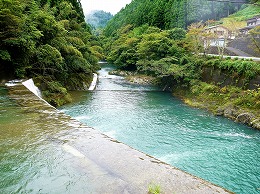 Located on the Pacific Ocean side of Shikoku, Kochi Prefecture has ample nature in the form of mountains, rivers, and the ocean. 83% of its area is forested, No. 1 in Japan. Annual rainfall in the prefecture is also No. 1 in Japan (for 2014), and it has plentiful water resources, including Shimanto River, known as the last pristine river in Japan. The Kuroshio Current, one of the largest currents in the world, flows through the ocean offshore from Kochi, allowing for an active fishing industry.
Located on the Pacific Ocean side of Shikoku, Kochi Prefecture has ample nature in the form of mountains, rivers, and the ocean. 83% of its area is forested, No. 1 in Japan. Annual rainfall in the prefecture is also No. 1 in Japan (for 2014), and it has plentiful water resources, including Shimanto River, known as the last pristine river in Japan. The Kuroshio Current, one of the largest currents in the world, flows through the ocean offshore from Kochi, allowing for an active fishing industry.
--- Preparing for predictions of tsunami up to 34 meters high --- 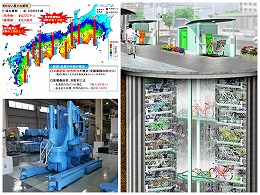
On the other hand, in the Kochi coast, preparations have been taken toward risk from tsunami that could occur along with the possible Nankai Trough earthquake, an earthquake along the Pacific side of Japan anticipated to be up to magnitude 9. To prepare for the estimates of tsunami up to 34 meters high, the prefectural government has been steadily improving measures, arranging evacuation routes and evacuation shelters, building tsunami evacuation towers in areas with no high ground, and working to raise residents’ disaster awareness. Kochi is also home to a company that has created a unique technique for pile-driving to create infrastructure resilient against disasters, and has exported it around the world as well as contributing to building levees in disaster-affected areas in Tohoku. This same company also recently developed a bicycle parking facility that stores the bicycles underground.
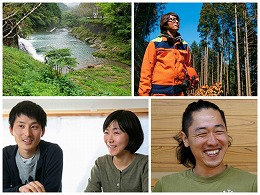
--- A mountain town putting a stop to population decline ---
In the highlands of Kochi, there is a small town that has put a stop to a declining population trend and is increasing the number of younger people relocating to the town. By providing excellent support for housing and raising children, over two and a half years 92 people relocated to the town with a population of only 3,659. The town is also known for being an early adopter of renewable energy. Currently the town is 30% self-sufficient with renewable energy, with a goal of 100% self-sufficiency by 2050.
--- The world’s thinnest paper, developed in an area famous for washi ---
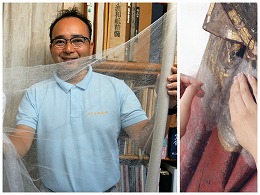
With its plentiful water, washi (Japanese paper) has been made in Kochi for over 1000 years. A small washi maker in this traditional area has succeeded in developing the thinnest paper in the world. This paper, only 0.02 mm thick, is used by experts around the world to restore cultural artifacts including ancient texts, paintings, and wooden statues, and has been used at the British Museum and the Louvre.
---------------------------------------------------------------------------------------------------------------------
This press tour will visit Kochi prefecture, and cover disaster prevention, efforts to reduce population decline, and innovation in craftsmanship.
・Kochi City: Kochi Prefectural office (Nankai Trough earthquake preparations, promotion of disaster-
prevention industry)
Giken Ltd. (Global pioneer in construction methods resilient to earthquakes and tsunami)
・Nankoku: Tsunami evacuation tower
・Hidaka: Washi maker that developed the world’s thinnest paper
・Yusuhara: Yusuhara Town Hall (policies to encourage permanent relocation),
young relocatees, examples of renewable energy
--------------------------------------------------------------------------------------------------------------------
*This press tour is a joint project by Kochi Prefecture and the FPCJ. It is also a commemorative project for the 40th anniversary of the FPCJ.
【Tour Details】
---------------------------------------------------------------------------------------------
<Theme Ⅰ>
- Preparing for a magnitude 9 earthquake and tsunami
- Pioneering construction method for levees resistant to tsunami
---------------------------------------------------------------------------------------------
1. Kochi Prefecture: Reinforcing Preparations for Nankai Trough Earthquake
—Dealing with predictions of tsunami up to 34 meters high
Kochi Prefectural Government, Risk Management Division, Nankai Trough Earthquake Team Leader, Yoshifumi Kubota
http://www.kochi-kia.or.jp/earthquake/
(information available in languages including Japanese, English, Chinese, and Korean)
http://www.pref.kochi.lg.jp/soshiki/010201/higaisoutei-2013.html

In August 2012, the Japanese government announced damage estimates for the Nankai Trough earthquake expected to occur in the future. The Nankai Trough earthquake is a massive, magnitude 9 earthquake being warned of that could occur over a broad area along the Nankai Trough located in the Pacific Ocean along Japan. Since many earthquakes have occurred in this area in the past, precautions are being strengthened.
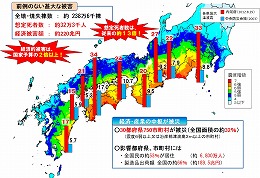 The national government’s damage estimates were made considering the Great East Japan Earthquake in 2011, and in the worst case scenario estimate 320,000 dead throughout Japan and 220 trillion yen in damages.
The national government’s damage estimates were made considering the Great East Japan Earthquake in 2011, and in the worst case scenario estimate 320,000 dead throughout Japan and 220 trillion yen in damages.
Kochi Prefecture then announced its own, independent estimate of damages within the prefecture. They noted that some areas could be hit by tsunami up to 34 meters high, among the largest in the country, and estimated 42,000 deaths (both worst case scenarios). These horrific predictions shocked people, and immediately after the announcement people seemed to have already given up. However, the prefectural government continued to work on policies based on these estimates to ensure that even in the worst case people would be able to escape and survive.
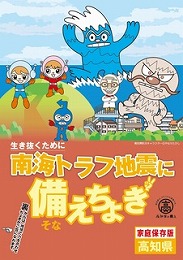 As a countermeasure for earthquakes, earthquake-resistance reforms to homes have been encouraged, and as of the end of March 2016, 77% of homes in the prefecture have been made earthquake resistant. Efforts have also been made to convince residents to evacuate quickly. To prepare for tsunami, evacuation routes and evacuation shelters (1,361) have been built, as well as building tsunami evacuation towers (90) and tsunami shelters. In order to ensure the practicality of local tsunami evacuation plans made by the 19 municipalities along the coast, prefectural and municipal employees walk along the actual evacuation route along with locals, checking for any dangerous spots.
As a countermeasure for earthquakes, earthquake-resistance reforms to homes have been encouraged, and as of the end of March 2016, 77% of homes in the prefecture have been made earthquake resistant. Efforts have also been made to convince residents to evacuate quickly. To prepare for tsunami, evacuation routes and evacuation shelters (1,361) have been built, as well as building tsunami evacuation towers (90) and tsunami shelters. In order to ensure the practicality of local tsunami evacuation plans made by the 19 municipalities along the coast, prefectural and municipal employees walk along the actual evacuation route along with locals, checking for any dangerous spots.
According to calculations by the prefecture, these initiatives have lowered the estimated number of deaths from 42,000 in May 2013 to 13,000 in March 2016 (including the effects of population decline). The prefectural government plans to further improve preparations, and bring this number as close to zero as possible.
◆The tour will visit the Kochi Prefectural Office, and hear from Nankai Trough Earthquake Team leader Mr. Kubota about the damage estimates, the measures taken in the three years since those estimates were announced in 2013, and future goals.
2. Tsunami Evacuation Towers
—Building places to escape to in areas without high ground
・Ominatosho-minami Tower
Nankoku City Hall (Kochi Prefecture), Risk Management Section Chief Manabu Nomura
http://www.city.nankoku.lg.jp/map/index.php?m=11&c=61
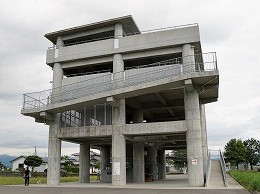
One measure Kochi Prefecture has been implementing to prepare for tsunami is building tsunami evacuation towers. These are steel and reinforced concrete buildings built in areas without high ground or tall buildings, for people to escape to in emergencies. The prefecture began building them in 2013, and has competed 90 of the 115 they plan to make.
Located in East-Central Kochi, Nankoku has 14 tsunami evacuation towers installed. According to the prefecture’s estimates for Nankai Trough earthquake damages, it was calculated that the city could be hit by tsunami of up to 16 meters, but there is very little high ground in areas close to the ocean. Therefore, the tsunami evacuation towers were built so people could quickly reach a safe area. The Ominatosho-minami Tower is one of these towers, built right beside an elementary school and preschool. In an emergency, those children and residents within 300 meters (five minutes walking distance) can escape to the tower, which is built to hold 361 people on three floors.
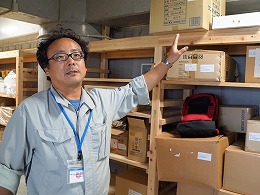 In addition to having stairs, this tower also has ramps allowing wheelchair access as well. It also has a storage area, with items necessary in an emergency stocked there, and panels available to build individual rooms including toilets. There is also space available where a rescue helicopter can hover.
In addition to having stairs, this tower also has ramps allowing wheelchair access as well. It also has a storage area, with items necessary in an emergency stocked there, and panels available to build individual rooms including toilets. There is also space available where a rescue helicopter can hover.
The towers in Nankoku do not have doors or keys, and are open to residents, who can enter at any time. Since it is important that people do not go there for the first time when there is an earthquake, they are used for local festivals and for viewing fireworks in order to get people used to going to the towers. Evacuation drills focused on the towers are also actively carried out by residents. According to Mr. Nomura, from the Nankoku City Hall Risk Management Section, “With the towers having been built, I feel like residents are more mindful of making sure to evacuate.”
◆The tour will visit the tsunami evacuation tower, and receive an explanation of its purpose before seeing the interior of the tower. There will also be an opportunity to see the boat-type tsunami survival shelter.
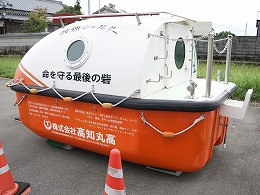
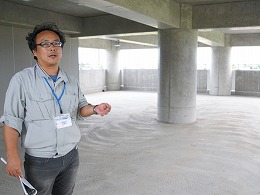
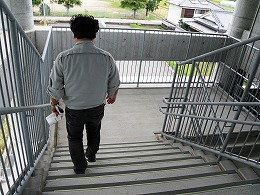
3. Kochi Prefecture: Aiming for Leadership in Disaster Prevention Industry
—Working towards overseas exports using accumulated knowhow
・Kochi Prefectural Government, Commerce, Industry, and Labor Department, Industrial Promotion Section, Chief Yuichi Kitamura
http://www.pref.kochi.lg.jp/soshiki/150501/bousaiseihin26.html
http://kuroshiocan.co.jp/index.html

Kochi is the prefecture where the second-highest number of typhoons make landfall in Japan (Kagoshima is first), with an annual rainfall of 1.6 times the national average. Therefore, the prefecture has experienced many large-scale wind and water disasters, and has accumulated knowledge for disaster prevention in a variety of areas, not just in preparing for earthquakes and tsunami. There are also many companies in the prefecture that manufacture products for disaster prevention. In order to support both outside sales and the local production and consumption of “Made in Kochi” disaster prevention products and technology, the prefectural government has established a system to certify products that pass quality and safety tests as Kochi Prefecture Registered Disaster Prevention Products, with 116 products currently registered. Among these are the products of a canning plant built in Kuroshio, where tsunami of up to 34 meters are predicted. These canned good are made by processing fresh, local fish, and do not include any of the seven most common allergens, making them popular with people with allergies.
Kochi Prefecture is also supporting exports by its disaster prevention industry. In September this year, the governor visited the Philippines, another country that frequently suffers from natural disasters, and promoted disaster prevention seminars and Made-in-Kochi disaster prevention products and technologies.
◆At the Kochi Prefectural Office, there will be a briefing on the prefecture’s strategy, and the chance to sample allergy-free canned goods made in Kuroshio.
4. Giken: A Global Pioneer in Construction Techniques Resistant to Earthquakes and Tsunami
—Contributing to construction in disaster-affected areas in Tohoku and of levees along the Kochi coast with unique pile implant technology
To prepare for the Nankai Trough earthquake and tsunami, levees along the Pacific Coast of Kochi are being reinforced. The method being used is a technique developed independently by local company Giken Ltd., involving implanting piles into the earth.
・Revolutionizing construction with the implant method
Giken Ltd. President Akio Kitamura
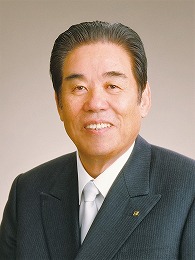
https://www.giken.com/en/company/message/
Piles are a critical part of construction. They have many uses, for the foundations supporting structures, retaining walls to keep back earth, and cut-off walls to hold back water. Giken Ltd., with its head office in Kochi, is a global pioneer that brought about a new technique for implanting these piles into the ground. The company president, Mr. Akio Kitamura, founded the company in 1967. The company now has headquarters in the China, Germany, the Netherlands, Singapore, the UK, and the US, and its techniques are used for upgrading and reinforcing construction along rivers, roads, harbors, and bridges in over 30 countries around the world.
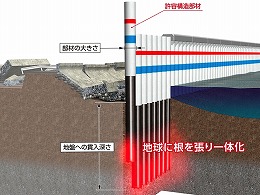 The “implant method” is Giken’s world-famous construction method. By pressing a pile that combines both the frame and the foundation in one deep into the earth, this method allows building strong structures combined with the earth. The structures made function as disaster prevention infrastructure resistant to earthquakes and tsunami. In addition to reinforcing levees along the coast in Kochi and Aichi, it is also being used for construction of levees and reconstruction projects along the coast and rivers in areas affected by the Great East Japan Earthquake.
The “implant method” is Giken’s world-famous construction method. By pressing a pile that combines both the frame and the foundation in one deep into the earth, this method allows building strong structures combined with the earth. The structures made function as disaster prevention infrastructure resistant to earthquakes and tsunami. In addition to reinforcing levees along the coast in Kochi and Aichi, it is also being used for construction of levees and reconstruction projects along the coast and rivers in areas affected by the Great East Japan Earthquake.
 The implant method is made possible by the Silent Piler, a pile jacking machine developed by Giken. By firmly gripping several of the piles that have already been pressed deep into the ground, the machine uses the withdrawal resistance of those piles to silently drive the next pile into the ground using hydraulic power. Different from existing methods to drive in piles using percussive or vibratory energy, Giken was the first to implement this press-in method with a piler. Effectively, by using the power of the earth, it is possible to achieve great force with a small machine. This enables high-precision, speedy implantation of piles without creating construction pollution such as noise and vibrations.
The implant method is made possible by the Silent Piler, a pile jacking machine developed by Giken. By firmly gripping several of the piles that have already been pressed deep into the ground, the machine uses the withdrawal resistance of those piles to silently drive the next pile into the ground using hydraulic power. Different from existing methods to drive in piles using percussive or vibratory energy, Giken was the first to implement this press-in method with a piler. Effectively, by using the power of the earth, it is possible to achieve great force with a small machine. This enables high-precision, speedy implantation of piles without creating construction pollution such as noise and vibrations.
◆President Akio Kitamura, an innovator called the Steve Jobs of his industry, will give an interview on the background of developing this technology, his philosophy towards disaster prevention, and future business plans. There will also be an opportunity to see the Silent Piler hydraulic pile jacking machine.
・Tsunami simulator: Test facilities to research levees resistant to tsunami
https://www.giken.com/en/vision/scientific_verification/
Giken has made a tsunami simulator in its head office to carry out tests by replicating tsunamis in a water channel. The goal is to prove the performance of structures built using the implant method, as well as to analyze the mechanism of damage to structures from tsunami.
◆The tour will observe an experiment done using the tsunami simulator.
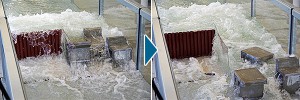
・Eco Cycle: Computer-controlled bicycle parking lot that stores bicycles underground
https://www.giken.com/en/solutions/underground_developments/eco_cycle/
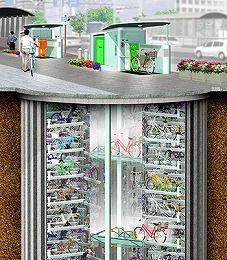 Bicycles have been gaining popularity as an environmentally-friendly form of transportation, but in urban areas in particular there is a shortage of bicycle parking, leading to bicycles being parked in places that cause problems. By applying its press-in technology, Giken developed Eco Cycle, an anti-seismic underground bicycle parking lot, to solve this issue.
Bicycles have been gaining popularity as an environmentally-friendly form of transportation, but in urban areas in particular there is a shortage of bicycle parking, leading to bicycles being parked in places that cause problems. By applying its press-in technology, Giken developed Eco Cycle, an anti-seismic underground bicycle parking lot, to solve this issue.
All that is above ground is a small booth for storage and retrieval of bicycles, with the storage space all underground. Therefore, it can also be built near stations and other locations without a lot of land available. The press-in piling materials function as earthquake-resistant structural walls, and the facility can store up to 204 bicycles. Bicycles can be automatically stored and retrieved using a computer-controlled system. Incredibly, a bicycle can be retrieved in as little as eight seconds. Currently, 50 Eco Cycles have been installed in 19 locations throughout Japan, including central Tokyo.
◆The tour will visit the demonstration Eco Cycle located on company grounds. The bicycle storage space that would normally be underground is above ground, so it is possible to see the entire system in action.
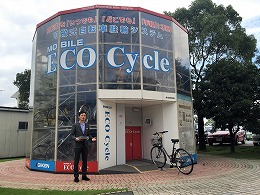
---------------------------------------------------------------------------------------------
<Theme Ⅱ>
Yusuhara, a town fighting against population decline.
Aiming for 100% self-sufficiency with renewable energy
---------------------------------------------------------------------------------------------
1. Yusuhara, Putting a Stop to Population Decline
—The number of young people relocating to this mountain town is on the rise, thanks to generous support for raising children and housing
・Yusuhara Town Hall, Planning and Finance Section Chief, Mayumi Matsuyama
Permanent Relocation Coordinator, Kosaku Kataoka
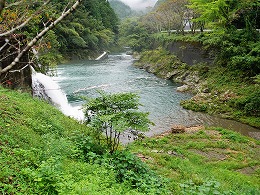 Japan’s population continues to decline. This trend is particularly severe in rural areas, where it is a major issue. A small town located in the mountains of Kochi, called “the town on top of the clouds” due to clouds sometimes forming lower than the town, is receiving a lot of attention for minimizing their population decline. That town is Yusuhara, a town of 3,659 people, surrounded by forest. In the two and a half years from April 2014 to the end of August 2016, 92 people have relocated to the town. The average age of these relocatees is 37, with many of them having young children.
Japan’s population continues to decline. This trend is particularly severe in rural areas, where it is a major issue. A small town located in the mountains of Kochi, called “the town on top of the clouds” due to clouds sometimes forming lower than the town, is receiving a lot of attention for minimizing their population decline. That town is Yusuhara, a town of 3,659 people, surrounded by forest. In the two and a half years from April 2014 to the end of August 2016, 92 people have relocated to the town. The average age of these relocatees is 37, with many of them having young children.
Like other towns in mountainous areas, Yusuhara had been troubled by population decline for many years. Therefore, in 2011 the town set the goal of increasing the population to 4,000 by 2020, and began encouraging people to relocate permanently to the town.
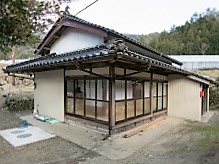 In 2013, the town started a system where it would lease vacant homes and renovate their kitchen, bathroom, and other facilities to fit modern lifestyles (spending up to 5.7 million yen), and then rent them out to relocatees at 15,000 yen per month. These vacant homes that had been transformed into pleasant living spaces were so popular, reservations were being made before renovations were even completed.
In 2013, the town started a system where it would lease vacant homes and renovate their kitchen, bathroom, and other facilities to fit modern lifestyles (spending up to 5.7 million yen), and then rent them out to relocatees at 15,000 yen per month. These vacant homes that had been transformed into pleasant living spaces were so popular, reservations were being made before renovations were even completed.
The town also provides ample support for raising children, with free daycare, free kindergarten, and free school lunches, as well as free medical treatment for children up to the age of 15. There is also a system to support junior high school and high school students studying overseas.

The town has a coordinator on hand to help relocatees with issues including homes, education, and employment, providing generous support to ensure they will become part of the community after relocating. The coordinator, Mr. Kataoka, is fully prepared, saying, “People can call me whenever they have a problem, no matter what time it is.” His kindness helps reassure the relocatees.
◆There will be a briefing at the town hall about Yusuhara’s policies to encourage permanent relocation.
2. Relocatee Interviews
—Members of younger generations who chose to leave the city and live in Yusuhara
http://www.yusuhara-iju.jp/life/
◆The tour will interview three relocatees who moved to Yusuhara, finding value different from that of the city.
・Composer/Musician/Musical Instructor, Taichiro Omura (35)
http://traceeverafter.wixsite.com/taichiomura/profile
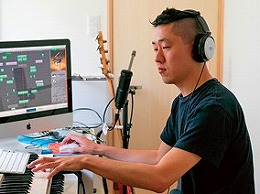 Mr. Omura lived in Tokyo for 15 years, working as a composer and contrabass performer. He began to want to raise his children somewhere besides Tokyo after the Great East Japan Earthquake in 2011, and moved to Yusuhara in 2013. While continuing to work as a composer, he also teaches music lessons in his home. He also teaches at a taiko club for local children. The town did not have a music expert until he moved there, but his presence has increased the number of musical opportunities for local children. Mr. Omura commented: “In Tokyo it felt like I was just carrying out the work given to me, but here I have the enjoyment of creating my own work.”
Mr. Omura lived in Tokyo for 15 years, working as a composer and contrabass performer. He began to want to raise his children somewhere besides Tokyo after the Great East Japan Earthquake in 2011, and moved to Yusuhara in 2013. While continuing to work as a composer, he also teaches music lessons in his home. He also teaches at a taiko club for local children. The town did not have a music expert until he moved there, but his presence has increased the number of musical opportunities for local children. Mr. Omura commented: “In Tokyo it felt like I was just carrying out the work given to me, but here I have the enjoyment of creating my own work.”
Mr. Omura’s family lives in a renovated, formerly vacant home that was built 100 years ago. Wanting to become a part of the community, they actively participate in town gatherings where the majority of participants are in there 70s and 80s. Mr. Omura said the best part about relocating to Yusuhara is how his child had changed. “Even just waking up in the morning and walking outside feels good. Before moving here, my child didn’t want to go to daycare and would fuss, but now they seem to be having fun.” He also appreciates the town’s policy of using renewable energy, considering the nuclear accident that occurred.
・Forestry, Sohei Ueda(34)
 Originally from Yusuhara, Mr. Ueda lived in Kochi City for six years before returning to the town again 10 years ago. Now he works in the forestry industry, a major industry in Yusuhara, cutting down cedar and cypress tress ready for harvesting, and thinning out the forest.
Originally from Yusuhara, Mr. Ueda lived in Kochi City for six years before returning to the town again 10 years ago. Now he works in the forestry industry, a major industry in Yusuhara, cutting down cedar and cypress tress ready for harvesting, and thinning out the forest.
When building his new home using local timber, he used all the subsidies from the town that he could. In total, with subsidies for permanent relocation by a young person, using local materials, for a septic tank, and for an environmentally-friendly water heater, he received approximately 4 million yen in subsidies. The father of two children, Mr. Ueda said: “For raising children, free daycare and free medical expenses up to the age of 15 are really helpful. With the support for raising children far beyond what other towns provide, it is an excellent environment for having children.”
・Outdoor Brand if you have, President Takashi Yamaguchi (32), Mariko Yamaguchi (36)
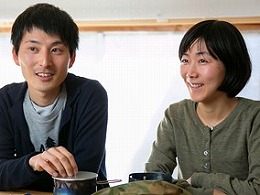 After having lived in Tokyo, overseas, and in Nagano, the Yamaguchis moved to Yusuhara in 2015. Fans of mountain climbing, they started “if you have” in order to make the outdoor goods they wanted themselves. They design and manufacture the products at home, and sell them on an online shop.
After having lived in Tokyo, overseas, and in Nagano, the Yamaguchis moved to Yusuhara in 2015. Fans of mountain climbing, they started “if you have” in order to make the outdoor goods they wanted themselves. They design and manufacture the products at home, and sell them on an online shop.
Mr. Yamaguchi mentioned how happy he was that they got along with their neighbors, who would bring over eggs and vegetables. When considering moving to Yusuhara, the relocation coordinator Mr. Kataoka showed them four different homes, and they were attracted by the fact that all of them had been renovated by the town and were ready to move in to immediately.
3. Yusuhara: 30% Self-sufficient with Renewable Energy, Goal of 100% by 2050
—Environmental policies becoming one of the town’s attractions
http://www.town.yusuhara.kochi.jp/town/environment/
・Yusuhara Town Hall, Environmental Planning Section, Environmental Model City Promotion Office,
Chief Kenzo Nakagoe
Director Yuichiro Sogame
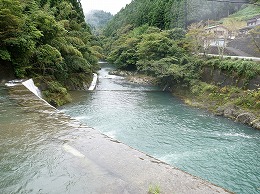 Taken advantage of its bountiful nature, Yusuhara was one of the first places in Japan to implement renewable energy like wind power, solar power, hydro power, and geothermal power. Currently, 30% of the town’s electricity is provided by renewable energy.
Taken advantage of its bountiful nature, Yusuhara was one of the first places in Japan to implement renewable energy like wind power, solar power, hydro power, and geothermal power. Currently, 30% of the town’s electricity is provided by renewable energy.
The windmills built on the highlands located 1,300 above sea level are a symbol of the town. The two windmills generate 380 kw of electricity per year, and the approximately 50 million yen (per year) from selling this electricity to power companies is used to support the town’s shift to an even more cyclical society. One example is the up to 800,000 yen subsidy for installing solar panels on homes. As a result, the town has one of the highest ratios of homes with solar panels in Japan, at one out of every 20 homes. The town is also involved in micro hydroelectric power and manufacturing wood pellets. The goal of the town is to be 100% self-sufficient with renewable energy by 2050. The town was designated by the national government as an environmental model city in 2009.
Among the relocatees with young children, there are some who mention the town’s use of renewable energy as one of its attractions.
◆After a briefing at the town hall about Yusuhara’s environmental policies, the tour will see a micro hydroelectric generator and a wood pellet plant.
・Micro Hydroelectric 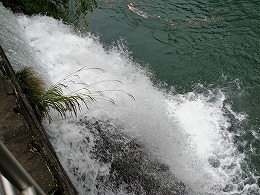
The town is involved in hydroelectric generation to take advantage of its ample river water. The electricity from a micro hydroelectric generator using a six-meter difference in elevation in the Yusuhara River is provided to nearby elementary and junior high schools, as well as being used for 82 streetlights at night.
・Yusuhara Pellet Co., Ltd.: Wood Pellet Plant
http://www.town.yusuhara.kochi.jp/town/environment/torikumi/pellet.html
With forests covering 91% of its area, forestry is a major industry in Yusuhara, and the town also converts the forest’s bounty into energy. A wood pellet plant is located in the town, where timber from thinning and wood debris are finely crushed before being compressed into solid fuel (pellets). The plant can produce up to 1,800 tons per year. The pellets made are used as fuel for boilers for hot water, agricultural purposes, and for air conditioning.
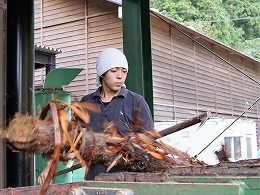

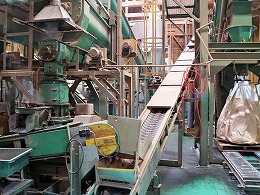
4. Architecture by Kengo Kuma Beautifying the Town
—Buildings using local wood and blending harmoniously with nature: one of the town’s attractions
・Environmental Planning Section, Construction Office Leader, Shingo Ueda
 Architect Mr. Kengo Kuma built the Kabukiza building completed in 2013, and is in charge of the design for the National Stadium being built for the 2020 Tokyo Olympics and Paralympics. There are four buildings designed by Mr. Kuma in the center of Yusuhara, making a strong impression on the townscape. They all use plenty of local timber, and blend in with nature. Mr. Kuma is known for his buildings using wood, but the first time he actually used a lot of wood was for Yusuhara’s municipal hotel Kumo no Ue no Hotel, built in 1994. It could be said that this hotel is the root of his architecture, leading up to the National Stadium.
Architect Mr. Kengo Kuma built the Kabukiza building completed in 2013, and is in charge of the design for the National Stadium being built for the 2020 Tokyo Olympics and Paralympics. There are four buildings designed by Mr. Kuma in the center of Yusuhara, making a strong impression on the townscape. They all use plenty of local timber, and blend in with nature. Mr. Kuma is known for his buildings using wood, but the first time he actually used a lot of wood was for Yusuhara’s municipal hotel Kumo no Ue no Hotel, built in 1994. It could be said that this hotel is the root of his architecture, leading up to the National Stadium.
Among the relocatees with young children, there are some who mention the beautiful scenery created by Mr. Kuma’s buildings as inspiring them to move to Yusuhara.
◆The tour will visit the Yusuhara Town Hall and the Kumo no Ue no Hotel, buildings designed by Mr. Kengo Kuma.
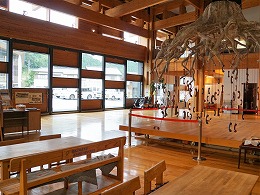


--------------------------------------------------------------
<Theme Ⅲ>
A small Japanese paper maker creating the thinnest paper in the world
--------------------------------------------------------------
1. A small Japanese paper maker creating the thinnest paper in the world
—Paper created in an area with 1000 years of history, used for restoring cultural artifacts in places such as the British Museum
・Hidaka Washi Co., Ltd.: President Hiroyoshi Chinzei 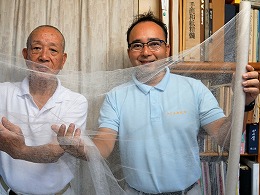
With its plentiful rivers, Kochi has long been a center for the production of washi (Japanese paper), which requires large quantities of water. The area is even mentioned as being known for washi in a document from around 920, for more than 1000 years of washi history in Kochi.
 A Kochi washi maker has gained attention for developing “the thinnest paper in the world.” Hidaka Washi has a total of eight employees. The paper the company makes is only 0.02 millimeters thick. One square meter weighs just 1.6 grams. Since it is transparent, whatever is on the other side of the paper can be seen clearly. The paper is made using kozo (paper mulberry), a traditional base for washi, and in addition to being transparent it is also very strong.
A Kochi washi maker has gained attention for developing “the thinnest paper in the world.” Hidaka Washi has a total of eight employees. The paper the company makes is only 0.02 millimeters thick. One square meter weighs just 1.6 grams. Since it is transparent, whatever is on the other side of the paper can be seen clearly. The paper is made using kozo (paper mulberry), a traditional base for washi, and in addition to being transparent it is also very strong.
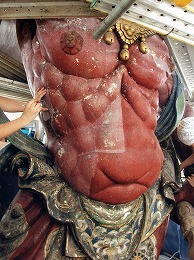 This washi is particularly prized by specialists in restoring cultural artifacts, such as antique documents and artwork. By applying it to damaged parts of book pages or paintings, the damaged area can be protected while steal being able to see the words and picture below due to the washi’s transparency. It is also used to prevent he paint on wooden statues, such as Buddha statues, from peeling. The Nio statue standing on the right side of the gate to Asakusa temple actually has had its body wrapped in this washi, but it is too thin to notice. This washi has also been used for restoration projects outside of Japan, including at the British Museum and the Louvre. Manor rare books were damaged in a 2004 fire at the Duchess Anna Amalia Library in Weimar, Germany, and this washi was used to restore them as well. So far, it has been used in 30 countries around the world, including in the US, Europe, Asia, and the Middle East.
This washi is particularly prized by specialists in restoring cultural artifacts, such as antique documents and artwork. By applying it to damaged parts of book pages or paintings, the damaged area can be protected while steal being able to see the words and picture below due to the washi’s transparency. It is also used to prevent he paint on wooden statues, such as Buddha statues, from peeling. The Nio statue standing on the right side of the gate to Asakusa temple actually has had its body wrapped in this washi, but it is too thin to notice. This washi has also been used for restoration projects outside of Japan, including at the British Museum and the Louvre. Manor rare books were damaged in a 2004 fire at the Duchess Anna Amalia Library in Weimar, Germany, and this washi was used to restore them as well. So far, it has been used in 30 countries around the world, including in the US, Europe, Asia, and the Middle East.
At Hidaka Washi, they used to make washi by hand, but they developed unique machines to achieve the thinnest washi possible. Making improvements over the years in order to meet customer needs, they managed to achieve the current thickness of 0.02 mm. Company president Mr. Hiroyoshi Chinzei commented, “Cultural artifacts that could no longer be displayed due to deterioration are restored using our washi, allowing people to see them again and pass their history along. I’m glad to be able to help with that.”
◆ The tour will visit Hidaka Washi and hear from Mr. Chinzei, as well as having the opportunity to see washi being made using their original machine. There will also be a demonstration of how washi is used for restoring cultural artifacts.
(*The copyright of the photo upper right belongs to Sensoji. Since the statue is in Asakusa, Tokyo, the tour will not see it in Kochi.)
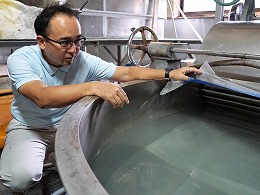
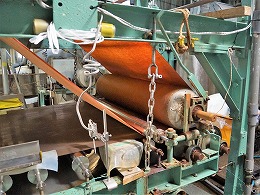
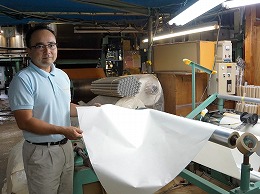
【Tour Itinerary】
1.Date : Monday, November 14 - Tuesday, November 15 (1 night, 2 days)
<Day 1. Monday, November 14: Nankoku City- Kochi City - Yusuhara Town>
|
Time |
Activity |
|
|
Meeting at Haneda Airport |
|
7:25-08:55(1h30) |
Haneda~Kochi(JAL) |
|
9:10-9:25(15) |
Chartered bus |
|
9:25-10:30(1h5)
|
Tsunami Evacuation Tower (Ominatosho-minami Tower)
|
|
10:30-:11:10(40) |
Bus |
|
11:20-12:35(1h15) |
Kochi Prefectural Office -Kochi Prefectural Government, Risk Management -Kochi Prefectural Government, Commerce,
|
|
12:40-13:15(35)
|
Lunch (Bento) sample allergy-free canned goods (TBD) |
|
13:20-13:35(15) |
|
|
13:45-15:30(1h45) |
Giken Ltd. Tsunami simulator Silent Piler Eco Cycle Interview with President Kitamura |
|
15:30-16:10(40) |
|
|
16:10-17:20(1h10) |
Hidaka Washi Co., Ltd.
|
|
17:30-18:15(45) |
Bus |
|
18:15 |
Hotel check-in |
|
18:45-20:00 |
Dinner |
<Day 2. Tuesday, November 15: Yusuhara Town>
|
Time |
Activity |
|
8:00 |
Hotel check-out |
|
8:00-9:00(60) |
Bus (Breakfast in bus) |
|
9:10-10:30(1h20)
|
Yusuhara Town Hall Planning and Finance Section (Permanent Relocation Environmental Model City Promotion Office Tour on Town Hall designed by Mr. Kengo Kuma |
|
10:30-10:40(10) |
|
|
10:40-11:20(40) |
Micro Hydroelectric
|
|
11:20-11:30(10) |
|
|
11:30-12:30(60) |
Lunch: at the Kumo no Ue no Hotel Photograph and film the building |
|
12:30-12:40(10) |
Bus |
|
12:40-13:25(45) |
Relocatee Interviews 1
|
|
13:30-14:15(45) |
Yusuhara Pellet Co., Ltd.: Wood Pellet Plant
|
|
14:15-14:30(15) |
|
|
14:30-15:15(45) |
Relocatee Interviews 2
|
|
15:15-15:25(10) |
|
|
15:25-16:10(45)
|
Relocatee Interviews 3
|
|
16:15-18:15(2h) |
Bus
|
|
19:10-20:30(1h15)
|
Kochi – Tokyo (JAL) |
2. Qualification: Bearer of Gaimusho Press Registration Card
3. Cost: 15,000 yen per person including transportation accommodation and meal (FPCJ will later inform the participants of methods for payment, cancellation fee, etc.)
*Those who wish to stay at the airport hotel on Thursday night, the cost will be covered by the organizer.
4. Participants: Limited to 10 applicants.
(Only one reporter and one photographer from each company, but two participants from each TV team will be acceptable.)
*If the number of applicants exceeds 10, an upper limit may be set on the number of participants from each country/region.
5. FPCJ Contact: Ms. Chika Yoshida (Tel: 03-3501-3405)
6. Remarks:
(1) There may be some restrictions on photographing and filming at the tour sites. Please follow the instructions of the officials on duty.
(2) Kochi Prefectural Government and FPCJ will not be liable for any inconvenience, trouble or accidents that might occur during the tour.
(3) This press tour will require participants to bear part of the cost, but is not a profit-making venture.
*****
Unauthorized use of the images for this article is forbidden.
Note: The following photos are provided by the owners.
-Theme Ⅰ
--1. Kochi Prefectural Government
--4. Giken Ltd.
-Theme Ⅱ-3. Yusuhara Town Hall (Cited from "Yusuhara Kurafuto")
-Theme Ⅲ-1. Sensoji ("Ungyo" statue.)



